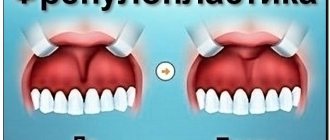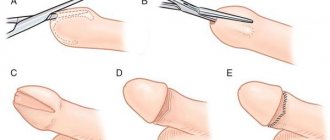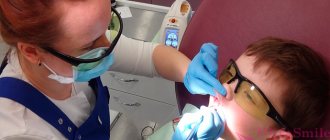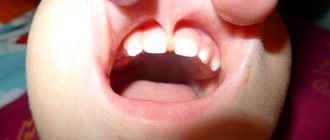Symptoms and clinical picture of a short frenulum of the tongue in a child
Signs of a short frenulum may not be noticed by inexperienced parents or those who do not know about this pathology; usually the problem is identified by nurses and doctors in the maternity hospital. The characteristic manifestations of ankyloglossia are as follows:
- when trying to stick out the tongue, it takes an arched position;
- when the tongue is raised, the frenulum is tensioned, as a result of which the body of the organ takes on the appearance of a heart;
- the tongue is fixed at the bottom of the oral cavity and cannot fully “come out” out.
Since the symptoms of a short frenulum of the tongue in a child are not obvious, you should pay attention to the following nuances.
In the first year of life, problems arise when breastfeeding. The child cannot properly grasp the nipple with his lips, squeezes it excessively with his gums, or bites it. This leads to malnutrition, hence anxiety and frequent crying.
Later, irregular teething may occur, with displacement or initial malocclusion.
At the time of speech development, difficulties are also noted; the child has difficulty pronouncing hissing and upper articulation sounds, and may burr.
At a later age, frequent and very painful tears of the shortened ligament are added to the described troubles.
Short frenulum of the tongue
Short frenulum of the tongue - causes, treatment. The condition, known as a tongue tie, severely limits the tongue's mobility during articulation and chewing. In such cases, certain treatment is required.
The membrane connecting the floor of the mouth and the tongue is called the frenulum. This piece of muscle tissue (a kind of fastening) limits the movement of the tongue and prevents it from dangling uncontrollably.
Problems with a short hyoid frenulum are usually resolved in early childhood; the pathology is visually determined immediately after the birth of the child or in the early stages of its development. Like any anomaly, a short frenulum of the tongue can cause a whole range of problems in the process of growing up, therefore, immediately after diagnosis, the disease must be treated.
Causes of the anomaly
Formed during the period of intrauterine development of the fetus, a short frenulum of the tongue can be caused by many factors associated with the condition and behavior of the mother during pregnancy.
The reasons may be of the following nature:
- Chronic diseases;
- Abdominal injuries;
- Bad ecology;
- Hereditary factor;
- Intrauterine infections;
- Infectious diseases of the mother in the first and last periods of pregnancy;
- Late motherhood (40 years and older).
Diagnostics
A short hyoid frenulum can be easily diagnosed visually. Depending on the degree of pathology (complete or partial), the child’s tongue is tightly fixed on the lower jaw or has very limited freedom of movement. Simply put, the baby cannot fully stick out his tongue.
As a result of the defective process of sucking mother's milk (the child is not able to wrap his lips around the nipple well), the baby is underweight. At a later age, a lisp and other speech (diction) defects can lead to problems with the child’s socialization, interfere with his communication with peers and cause depression.
Having found out the causes of the disease (pathology), treatment can begin.
Treatment of ankyloglossia
An operation to correct pathology of the frenulum of the tongue is called frenuloplasty. This is the most common type of treatment in modern conditions, effective and reliable.
There are several methods for performing frenuloplasty (according to Glikman or Vinogradova, Y-shaped and Z-shaped), but they all agree on one thing - excision of the frenulum, relocation of the place of its fixation and suturing. The operation is performed under local or general anesthesia, and after surgery, special exercises and classes with a speech therapist are required to develop speech skills.
Recently, a laser technique has begun to be used to correct a short frenulum of the tongue. After treating the tissue with a special gel, a focused laser beam is directed at the frenulum, which practically dissolves it. The entire operation takes a few minutes and is well tolerated by young children.
Painless and quick, laser frenuloplasty does not cause complications and does not require sutures. The healing process is also quick and painless.
A short tongue frenulum is not a problem
After the use of lasers became widespread in medicine, tongue tie began to be treated with a new painless method. Elimination of anomalies of the hyoid frenulum has ceased to be problematic due to the versatility of the new technique and the absence of complications in the postoperative period.
Waiting for a baby and his birth is a great happiness for parents. And at the same time there is a great responsibility, including for the health of the child. Parents, naturally, are very upset when their baby is diagnosed with any disease. Sometimes in young children a pathology is found that is called a short frenulum of the tongue. It is easy to diagnose visually. But don’t worry, aesthetic dentistry can easily solve this problem. And, to dot all the i's, we will answer questions about the treatment of this disease.
Basic treatment methods and contraindications
Ideally, dissection of the frenulum should be performed in the first days of the child’s life, but there are 2 options for the development of events.
In infancy, the incision is made by a surgeon using scissors, which at this stage of life is absolutely painless, since there are still no nerve endings in this area. After this, the baby is applied to the breast in order to calm and prevent the development of bleeding.
How to treat a short frenulum of the tongue in older children? Also, the operation will only be more painful, since the membrane thickens over the years. Typically, frenuloplasty is performed - transfer of the site of fusion of the frenulum, followed by suturing.
How to understand whether a tongue frenulum is short or not? Symptoms of dysarthria
Author: Olga Sakharovskaya, speech therapist-practitioner, specialist in speech therapy, probe, fascial massage and myofascial centering.
Most often in practice these two violations occur separately, less often together. Parents come to me for consultation with complaints that a child of 3 years old does not speak and he is diagnosed with motor alalia (the parents are in a panic, since they have already been on the Internet and Googled it). Or a child’s speech at 4 years old is incomprehensible, he has “porridge” in his mouth, cannot pronounce some words, and he is diagnosed with delayed speech development (also panic, since we have read all sorts of horror stories on the forums).
Or maybe the reason is a short frenulum of the tongue, it needs to be trimmed and then the child will speak? I ask what the child’s neurological progress is? What does the neurologist diagnose? And everything is fine in the child’s chart, the neurologist writes: healthy. I'm starting to explore. And it turns out that the primary cause of sound pronunciation disorders or lack of speech is dysarthria.
As a rule, dysarthria has minimal manifestations or an erased form, less often a moderate form, and even less often a severe form. It happens that two disorders are combined: short frenulum and dysarthria. With this option, the tongue is inactive, as a rule, muscle tone is increased (spastic) and movements are limited.
In addition to using tests for dysarthria, I examine the structure of the articulatory apparatus and look at the following criteria: tempo, switchability of movements of the tongue and lips, whether the child maintains a given articulatory position, assess the prosodic system (voice, breathing), assess the state of the muscle tone of the tongue and the state of the hypoglossal ligament/ bridles. I conduct the examination in the presence of the parents, and at the same time I explain what I am doing, why and why this happened to the child. At the end of the consultation, I answer the most important questions.
Which is not affected by the length of the bridle.
- On the formation of the communicative function.
- For delayed speech development.
- On the formation of the grammatical structure of speech.
It is important to know!
- The length of the frenulum influences the formation of the correct phonetic structure of the sounds of the upper instep: R, Rb, Sh, Zh, Ch.
- The length of the frenulum affects the formation of the bite.
- The length of the frenulum affects the volume and usefulness of tongue movement in the oral cavity (sucking, chewing, swallowing).
The main signs of a short frenulum:
- The tip of the tongue is attached to the floor of the mouth: this significantly limits its mobility.
- The frenulum is shortened in the anterior part, often representing a transparent thin film, devoid of blood vessels. As the film matures, it becomes denser and blood vessels form in it.
- The tongue folds into a groove or “heart” shape, which produces a characteristic clicking sound.
What the numbers say:
- The incidence of a short frenulum of the tongue is 1 case per 1000 newborns.
- In boys, a short frenulum of the tongue occurs 3 times more often than in girls.
Modern surgery offers to perform frenuloplasty using a laser:
- This is a bloodless procedure lasting no more than 10 minutes.
- During the manipulation, the vessels of the mucous membrane are welded together and do not require a suture.
- The laser has a bactericidal effect.
- The recovery period is very short.
- No scars form under the tongue.
- The child will forget about the procedure the next day. There are pathologies of the frenulum that require more serious surgical intervention with sutures (the surgeon chooses the method of correcting the frenulum).
Modern speech therapy in most cases suggests pulling the frenulum. What is my opinion, cut or pull?
After an in-person examination, I determine a course of action and discuss possible options with parents:
- Pull the hyoid ligament using special speech therapy articulation exercises and massage techniques. This process can take from 1 month or longer (I’m giving real correction times based on my 20 years of practical experience), provided that there are visits to a speech therapist 2-3 times a week.
- Prepare the articulatory apparatus for surgical intervention (I use special massage techniques to work the floor of the mouth, release clamps, remove tension, relieve spasticity from the muscles of the neck, face, tongue).
- Refer to a surgeon for plastic surgery of the lingual frenulum.
- After 7-10 days, continue speech therapy work on speech correction, which includes points No. 1, 2.
Short lip frenulum and frenuloplasty
Essential anatomical formations in dentistry and periodontology are: vestibule of the oral cavity, free gum, mobile gum, attached gum, transitional fold, frenulum of the upper and lower lips.
Vestibule of the oral cavity
- this is the space between the teeth and/or edentulous alveolar ridge, on the one hand, and the lips and cheeks, on the other hand.
If its depth, that is, roughly speaking, the distance (height) from the deepest place - the transitional fold to the necks of the teeth, free gums or the top of the toothless alveolar ridge, is less than 6 -7 mm, then it, the vestibule, is considered small. In this case, movements and tensions of the surrounding muscles can, breaking the barrier of the attached gum (this is the immobile rigid gum between the transitional fold and the free gum), pull the gum away from the necks of the teeth and dental implants and, over time, lead to recession (exposure of the necks of the teeth) of the gums, gingivitis, marginal periodontitis. The result of this process will be loosening and loss of teeth or implants. This anatomical feature, for preventive or therapeutic purposes, requires surgical correction - deepening the vestibule of the oral cavity
.
Figure 1. Diagram of the oral cavity organs in a sagittal section along the central incisors: 1 – upper lip pulled forward, 2 – low attached frenulum of the upper lip, 3 – upper transitional fold, 4 – upper jaw, 5 – lower lip, 6 – lower vestibule, 7 – lower jaw, 8 – tongue.
Frenum of the upper or lower lip
- This is a two-layer fold of the mucous membrane, triangular in profile, in shape along the midline of the vestibule of the oral cavity of the upper and lower jaw. Its point of attachment on the attached gum is approximately 5 mm from the gingival margin. On the other hand, the frenulum smoothly goes into the lip. An anatomical feature such as a short (or strong) frenulum of the lip stands out. In this case, the gingival point of attachment of the frenulum is very close to the interdental space (papilla). Movements of the lip muscles, as in the case of the small vestibule of the oral cavity, cause tension in the gingival margin between the central incisors (the gums may turn pale when the frenulum is pulled). The presence of a short frenulum, in addition, may be associated with a condition such as the appearance of spaces (three and diastemas) between the teeth.
Figure 2. The vestibule of the oral cavity and the short frenulum of the upper lip, front view: 1 – upper lip, 2 – attached gum, 3 – lower point of attachment of the frenulum, 4 – body of the frenulum, 5 – frenulum merges with the lip.
Surgical correction of the condition of a short frenulum is frenuloplasty
, excision of the frenulum, or, which is the same, frenotomy and frenectomy. During this manipulation, a V-shaped incision is made along the contour of the attachment of the frenulum to the gingival margin and to the attached gum, the cut-off tissue is pulled towards the lip and sutured. Thus, a vertical suture of 3–4 ties is formed from the lip to the transitional fold and a small open V-shaped wound surface between the transitional fold and the gingival margin. It heals by secondary intention.
Figure 3. Tissues of the vestibule of the oral cavity after frenuloplasty: 1 - open V-shaped wound surface between the transitional fold and the gingival edge, 2 - vertical suture from the lip to the transitional fold.
To be continued…
Short bridles
Speech therapists notice deviations in the development of some children: the inability to suck properly and feed through a pacifier, incoherent speech, slow growth and weight. Most often this is due to a violation of the structure of the oral cavity. A shortened frenulum is quite common in newborns; previously, during the initial examination of the child, neonatologists themselves trimmed it. However, dentists are now doing this. The task of each parent is to monitor whether breastfeeding and feeding through the nipple is normal, and if problems with a shortened frenulum are detected, immediately contact a specialist.
The procedure for removing a shortened frenulum is painless, no stitches are required, so there are no scars. Plastic surgery is also performed between the ages of 5 and 9 years, since at this time parents who were unable to identify the disorder in the early stages notice disturbances in the phonetics of speech.
Another common problem is a short frenulum of the upper lip. Pathology causes a gap to appear between the teeth, which does not look aesthetically pleasing. Also, problems with a short frenulum at a later age threaten the formation of malocclusion and the development of periodontitis. If a child has uneven teeth and needs orthodontic services, a short frenulum can cause problems when treated with braces or plates. Dentists recommend not to delay cutting the frenulum, because this causes problems with feeding and development of the speech apparatus. Surgery related to a short frenulum is performed under local anesthesia, and sutures are used that are removed after a week. As a rule, treatment gives quick results: after a few weeks, the child begins to clearly pronounce vowel sounds that require the participation of the lips.
You can determine whether plastic surgery of the frenulum of the upper lip is required based on the following criteria:
- A noticeable gap between the front teeth of the upper jaw;
- Poor pronunciation of some vowels and consonants involving the lips;
- Various taste anomalies;
- Gum disease;
- Difficulty sucking, feeding.
Experts say that plastic surgery can be performed at any age. However, the best age is 5-7 years, when the child is already aware of what is happening, or up to a year, when medical examinations and treatment can be carried out without his participation. A necessary condition is the baby's immobility during work, which is not always possible to achieve with children 2-4 years old.
In the postoperative period, it is important to exclude all hard vegetables, rough and hot foods from the diet, carefully monitor oral hygiene and take a vitamin complex.
Adults also require correction of the upper frenulum. Features and recommendations for plastic surgery are as follows:
- Future treatment by an orthodontist (for example, installation of braces, crowns);
- Correction of malocclusion;
- Recession and inflammation of the gums;
- Dental implantation;
- Complication of periodontal disease;
- Fixation of removable dentures.
In the case of treating an adult, the operation will not be as simple as in the case of children. To perform the work, you will need local anesthesia, stitches will be placed, and you will need to visit a doctor in the next few months.











